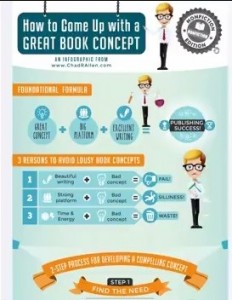
A Great Book Concept…. how does that happen?
Just an update, "The Author's Art" mastermind event that we are hosting in June is now 2/3 sold out. All LIVE attendee seats are sold and we have just a few virtual seats left.
Today I thought we'd have some fun and I asked Chad, a featured guest at this event, to write an article to share with all of you just some of what he offers his clients. Chad has helped many authors go from a blank page to best seller. Today he's going to share with you 5 tools you must have in place to get you started on your winning book concept. Take note: he reviews proposals nearly every week. So he knows what works and what doesn't! Now you can have the 'inside secrets' from a publisher on what they want!
With love,
Sandi Krakowski

Writing a Book Is Not as Hard as You Think If You Use These 5 Tools
Do you have a book in you? According to a New York Times article, over 80 percent of Americans answer yes to this question, yet only a fraction end up actually writing one.
That’s a problem. It’s a problem for millions of would-be writers whose book-writing dreams go unfulfilled. It’s also a problem for readers who could have benefited enormously from these books! Todd Henry makes the point that cemeteries are the most valuable real estate on earth because there are buried the unfulfilled dreams of so many.
If you have a message or a story to share, writing a book is a great way to do it, and you can do it. This post will give you some tools to help you get started. (One caveat: this post is mainly for nonfiction writers. Fiction writers may find some tools that are transferable here, but it is intended for nonfiction writers.)
Tool #1: Brainstorming
The usefulness of a good brainstorming session cannot be overestimated. Struggling to nail down a concept? Try brainstorming titles and subtitles. Having difficulty deciding what your chapters should be? Brainstorm topics, stories, and principles, then move things into a logical order. Don’t know how to promote your book? Start brainstorming. Sometimes it can take several sessions to come up with ideas you like, but brainstorming is the oil that gets the engine revving.
Tool #2: The Interview-and-Transcribe Method
Sometimes the blank screen can be daunting. Try this. Make an outline of what you want to say. Then create questions that a friend can ask you. Record the Q&A session between you and your friend, and use Elance or freelancer.com or Rev to have the recording transcribed. (I did this recently, and the cost was about $20 per audio hour.) Do one interview per chapter. This will get you past the blank screen. You’ll still have a lot of work to do, but you’ll be starting with a lot more than nothing! (Tip: Find a friend who’s also writing a book so you can interview each other.)
Tool #3: Close Gaps with Questions
Are you looking for a story or metaphor or idea to fill a content gap? Write yourself a question on an index card or white board or anywhere else you’ll see it regularly. If you keep the question in front of your consciousness, you’ll be surprised how quickly you find a solution. (Example: “What’s a good story to illustrate how sad it is that so many books are never written?” This question led me to the cemetery reference above.)
Tool #4: Anti-social
This $15 app shuts down Twitter, Facebook, and any other site you designate for however long you say. That way you’ll still have access to the Internet for research, but you won’t get distracted by the constant ping of social media.
Tool #5: Write a Book Proposal
As with many things, the hardest part is getting started. Take exercise, for example. The most difficult part is waking up, getting dressed, and putting on the right shoes. Once this is done you’re on your way. The equivalent to getting the hard part of a book project done is writing a book proposal. The work it takes to write a book proposal is less daunting than a whole manuscript. Yet once you’ve completed your book proposal, you’re on your way!
A Special Gift for Sandi Krakowski Readers
I put together a resource kit especially for Sandi Krakowski readers, just because I love Sandi (and you!) so much. Visit this exclusive page, enter your email address, and I’ll send some items I’ve prepared specially for you. Here’s what you’ll get:
- A powerful infographic on how to come up with a great book concept. I collaborated with an artist to design this. It unveils a process for brainstorming and refining your ideas so you’ll know exactly what book concept you should pursue.
- A video tutorial in which I talk through the infographic and help you apply it to your situation.
- My Book Proposal Guidelines, used by countless authors to write their book proposals.
Get it all here.
Take care, and happy writing!
Chad Allen

Editorial Director, Baker Books




